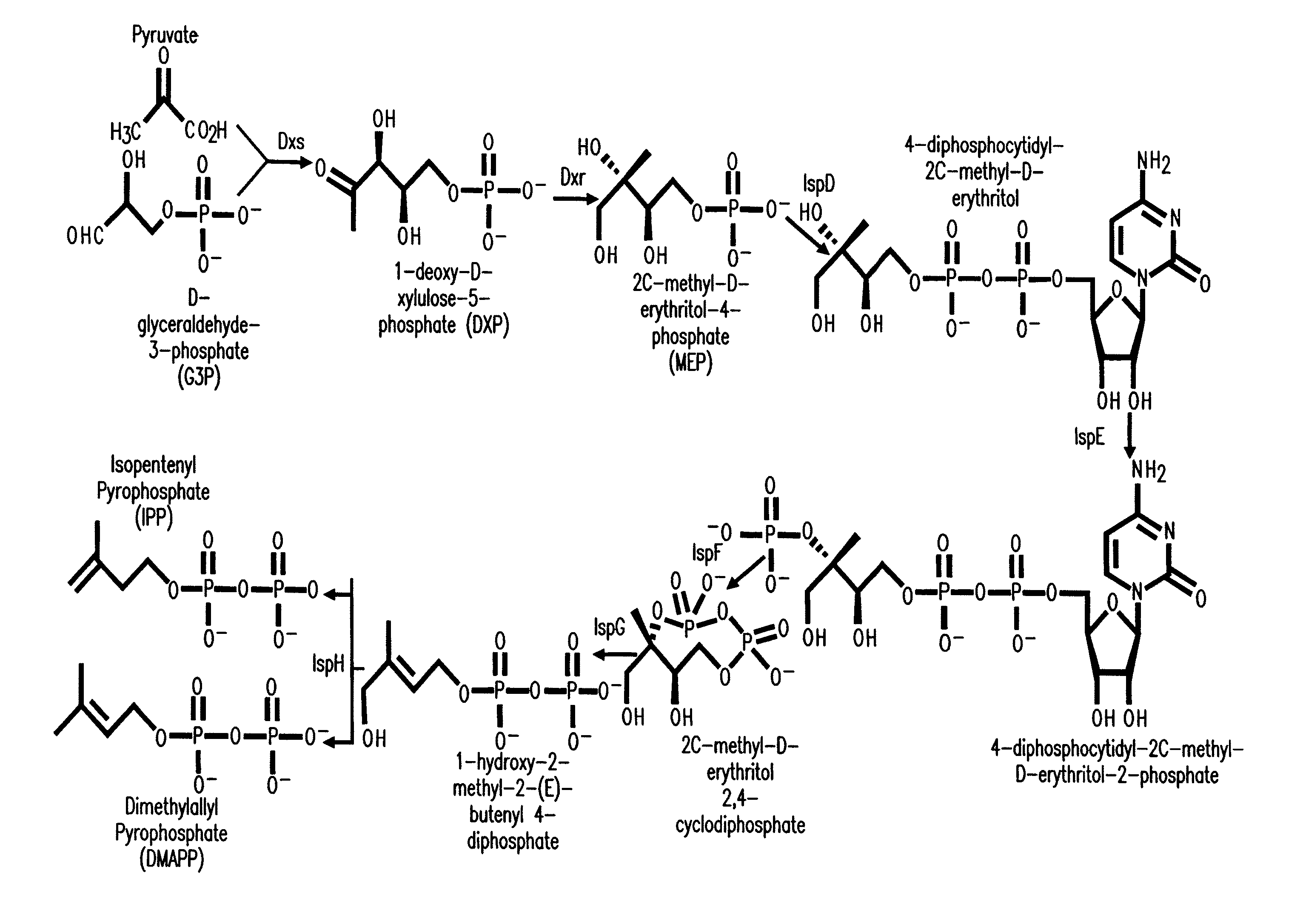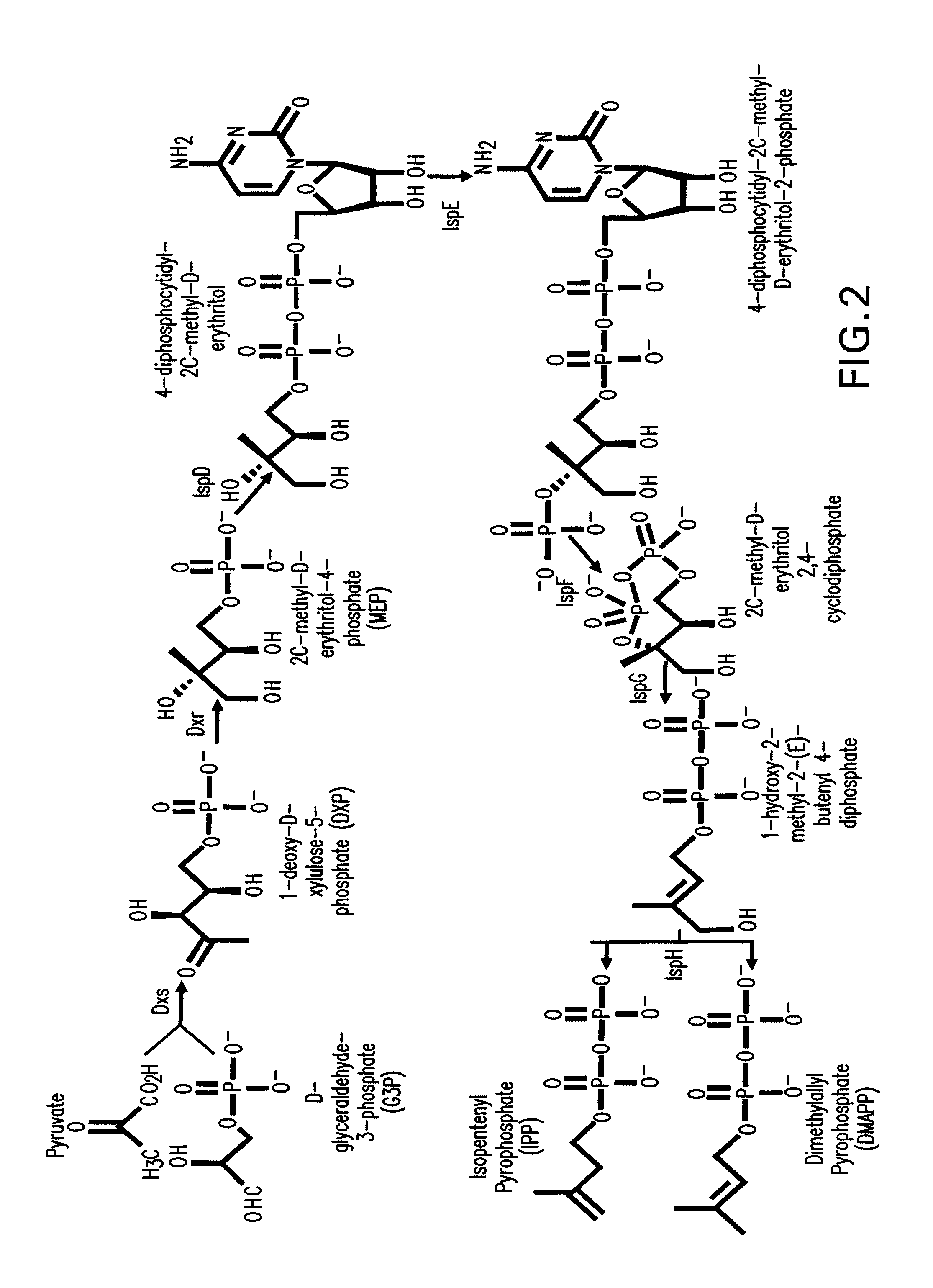Production of isoprenoids
a production method and technology of isoprenoids, applied in the field of isoprenoids, can solve the problems of inability to meet the needs of source organisms in general, low yield by extraction, and accumulation of most isoprenoids, and achieve the effect of robust production of isoprenoids
- Summary
- Abstract
- Description
- Claims
- Application Information
AI Technical Summary
Benefits of technology
Problems solved by technology
Method used
Image
Examples
example 1
[0185]This example describes methods for making vectors for the targeted integration of nucleic acids encoding enzymes including enzymes of the MEV pathway into specific chromosomal locations of Saccharomyces cerevisiae.
[0186]Genomic DNA was isolated from Saccharomyces cerevisiae strains Y002 and Y003 (CEN.PK2 background MATA or MATα ura3-52 trp1-289 leu2-3,112 his3Δ1 MAL2-8C SUC2) (van Dijken et al. (2000) Enzyme Microb. Technol. 26:706-714), Y007 (S288C background MATA trp1Δ63) (ATCC number 200873), and EG123 (MATA ura3 trp1 leu2 his4 can1) (Michaelis & Herskowitz. (1988) Mol. Cell Biol. 8: 1309-1318). The strains were grown overnight in liquid medium containing 1% Yeast extract, 2% Bacto-peptone, and 2% Dextrose (YPD medium). Cells were isolated from 10 mL liquid cultures by centrifugation at 3,100 rpm, washing of cell pellets in 10 mL ultra-pure water, and re-centrifugation. Genomic DNA was extracted using the Y-DER yeast DNA extraction kit (Pierce Biotechnologies, Rockford, Il...
example 2
[0195]This example describes methods for making plasmids and DNA fragments useful in the embodiments provided herein.
[0196]Plasmid pAM584 was generated by inserting DNA fragment GAL74 to 1021-HPH-GAL11637 to 2587 into the TOPO ZERO Blunt II cloning vector (Invitrogen, Carlsbad, Calif.). DNA fragment GAL74 to 1021-HPH-GAL11637 to 2587 comprises a segment of the ORF of the GAL7 gene of Saccharomyces cerevisiae (GAL7 nucleotide positions 4 to 1021) (GAL74 to 1021), the hygromycin resistance cassette (HPH), and a segment of the 3′ untranslated region (UTR) of the GAL1 gene of Saccharomyces cerevisiae (GAL1 nucleotide positions 1637 to 2587). The DNA fragment was generated by PCR amplification as outlined in Table 6. FIG. 4F shows a map and SEQ ID NO: 9 the nucleotide sequence of DNA fragment GAL74 to 1021-HPH-GAL11637 to 2587.
TABLE 6PCR reactions performed to generate pAM584PCRRoundTemplatePrimer 1Primer 2PCR Product1100 ng of Y002 genomic DNA91-014-CPK236-91-014-CPK237-GAL74 to 1021G (...
example 3
[0201]This example describes the generation of Saccharomyces cerevisiae strains useful in the embodiments provided herein.
[0202]Saccharomyces cerevisiae strains CEN.PK2-1C Y002 and Y003 (MATA or MATalpha; ura3-52; trp1-289; leu2-3,112; his3Δ1; MAL2-8C; SUC2) (van Dijken et al. (2000) Enzyme Microb. Technol. 26(9-10):706-714) were prepared for introduction of inducible MEV pathway genes by replacing the ERG9 promoter with the Saccharomyces cerevisiae MET3 promoter, and the ADE1 ORF with the Candida glabrata LEU2 gene (CgLEU2). This was done by PCR amplifying the KanMX-PMET3 region of vector pAM328 (SEQ ID NO: 6), which comprises the PMET3 promoter preceded by the kanamycin resistance marker flanked by the promoter and terminator of the Tef1 gene of Kluyveromyces lactis, using primers 50-56-pw100-G (SEQ ID NO: 10) and 50-56-pw101-G (SEQ ID NO: 11), which include 45 base pairs of homology to the native ERG9 promoter, transforming 10 ug of the resulting PCR product into exponentially gr...
PUM
| Property | Measurement | Unit |
|---|---|---|
| weight | aaaaa | aaaaa |
| concentration | aaaaa | aaaaa |
| concentration | aaaaa | aaaaa |
Abstract
Description
Claims
Application Information
 Login to View More
Login to View More - R&D
- Intellectual Property
- Life Sciences
- Materials
- Tech Scout
- Unparalleled Data Quality
- Higher Quality Content
- 60% Fewer Hallucinations
Browse by: Latest US Patents, China's latest patents, Technical Efficacy Thesaurus, Application Domain, Technology Topic, Popular Technical Reports.
© 2025 PatSnap. All rights reserved.Legal|Privacy policy|Modern Slavery Act Transparency Statement|Sitemap|About US| Contact US: help@patsnap.com



